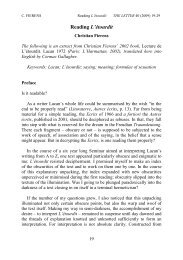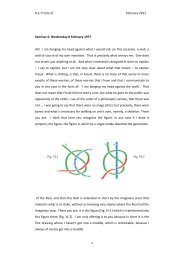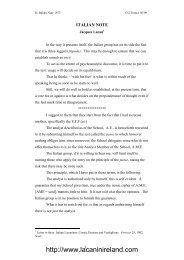mean to deny? What can one deny? This plunges us <strong>in</strong>to the Verne<strong>in</strong>ung ofwhich Freud has put forward the essentials. What he enunciates, is that negationpresupposes a Bejahung. It is start<strong>in</strong>g from someth<strong>in</strong>g that is enunciated aspositive, that one writes negation. In other words, the sign is to be sought – andthis <strong>in</strong>deed is what, <strong>in</strong> this agency of the letter, that I posed – is to be sought ascongruence of the sign to the Real.What is a sign that one cannot write? For one really writes this sign. I highlightedlike that, at one time, the pert<strong>in</strong>ence of what the French lalangue touches on asadverb. Can one say that the Real lies (ment)? In analysis, one can surely say thatthe True lies. Analysis is a long journey (chem<strong>in</strong>ement) – one f<strong>in</strong>ds it everywhere– that the chem<strong>in</strong>e-ne-mente (the journey does not lie) it is someth<strong>in</strong>g which canonly on occasion signal to us that, as <strong>in</strong> the wire of the telephone, that we f<strong>in</strong>d ourfoot<strong>in</strong>g.And then, that such th<strong>in</strong>gs can be put forward poses the question of what issense. Is sense supposed to be only ly<strong>in</strong>g, s<strong>in</strong>ce one can say that the notion of theReal excludes – which should be written <strong>in</strong> the subjunctive – that it excludes(qu’elle exclue) sense? Does that <strong>in</strong>dicate that it also excludes the lie? This<strong>in</strong>deed is what we have to deal with, when we wager <strong>in</strong> short on the fact that theReal excludes – <strong>in</strong> the subjunctive, but the subjunctive is the <strong>in</strong>dication of themodal – what is modulated <strong>in</strong> this modal that would exclude (excluerait) the lie?In truth, - we sense it clearly -, there is noth<strong>in</strong>g <strong>in</strong> all of that but paradoxes.Are paradoxes representable? Doxa, is op<strong>in</strong>ion, the first th<strong>in</strong>g on which I<strong>in</strong>troduced a lecture, at the time of what one can call or that one could call mybeg<strong>in</strong>n<strong>in</strong>gs, it is <strong>in</strong> the Meno <strong>in</strong> which it is enunciated that doxa, is true op<strong>in</strong>ion.There is not the slightest true op<strong>in</strong>ion, s<strong>in</strong>ce there are paradoxes. This is thequestion that I am rais<strong>in</strong>g, whether paradoxes are or are not representable, Imean depictable (dess<strong>in</strong>ables). The pr<strong>in</strong>ciple of true say<strong>in</strong>g, is negation, and mypractice, s<strong>in</strong>ce there is a practice, a practice about which I question myself, is that,that I slide, I have to slide, because that is the way it is constructed, between thetransference, that is called, I do not know why, negative, but it is a fact that it iscalled that. It is called negative because people clearly sense that there is118
someth<strong>in</strong>g, we still do not know what positive transference is, positivetransference, is what I tried to def<strong>in</strong>e under the name of subject supposed toknow. Who is supposed to know? It is the analyst. It is an attribution, as isalready <strong>in</strong>dicated by the word supposed; an attribution is only a word; there is asubject, someth<strong>in</strong>g which is underneath which is supposed to know. To know istherefore its attribute. There is only one problem, which is that it is impossible togive the attribute of know<strong>in</strong>g to anyone.The one who knows, is, <strong>in</strong> analysis, the analyser, what he unfolds, what hedevelops, is what he knows, except for the fact that it is an Other, - but is there anOther? -, that it is an Other who follows what he has to say, namely, what heknows. The notion of the Other, I marked <strong>in</strong> a certa<strong>in</strong> graph with a bar whichbreaks it, Ø. Does that mean that when broken it is denied? Analysis, properlyspeak<strong>in</strong>g, enunciates, that the Other is noth<strong>in</strong>g but this duplicity.There is someth<strong>in</strong>g of the One (Y a de l’Un), but there is noth<strong>in</strong>g other. The One,as I have said, the One dialogues all alone, s<strong>in</strong>ce it receives its own message <strong>in</strong> an<strong>in</strong>verted form. It is he who knows, and not the one supposed to know.I put forward also this someth<strong>in</strong>g which is enunciated about the universal, andthis to deny it; I said that there is no all (tous). This <strong>in</strong>deed is why women, aremore man than men. They are not-all (pas-toutes), as I said. These all therefore,have no common trait; they have nevertheless this one, this s<strong>in</strong>gle common trait,the trait that I described as unary. They are comforted by the One. There issometh<strong>in</strong>g of the One, I repeated it just now to say that there is someth<strong>in</strong>g of theOne, and noth<strong>in</strong>g else. There is someth<strong>in</strong>g of the One, but that means that thereis all the same some k<strong>in</strong>d of feel<strong>in</strong>g. This feel<strong>in</strong>g that I called, accord<strong>in</strong>g to theunaries (unarités) that I called the support, the support of what <strong>in</strong>deed I mustrecognise, hatred, <strong>in</strong>sofar as this hatred is ak<strong>in</strong> to love; la mourre that I wrote <strong>in</strong> –I must all the same f<strong>in</strong>ish on this – that I wrote <strong>in</strong> my title for this year: l’<strong>in</strong>su quesait, what? de l’une-bévue. There is noth<strong>in</strong>g more difficult to grasp than this traitof the une bévue. This bévue – is that by which I translate Unbewusst, namely, theUnconscious. In German, that means unconscious, but translated by une bévue, itmeans someth<strong>in</strong>g completely different, that means a stumbl<strong>in</strong>g, a tripp<strong>in</strong>g up, a119
- Page 1:
Seminar 1: Wednesday 16 November 19
- Page 5 and 6:
after all noticed that to consist m
- Page 7 and 8:
It would be enough for you to take
- Page 9 and 10:
There had therefore been a turning
- Page 11:
Supposing that we have a torus in a
- Page 15 and 16:
topology encourages us to do so. Th
- Page 17 and 18:
and me, and I who, in short, by din
- Page 19 and 20:
we cut it in two, the front and the
- Page 21 and 22:
is itself a hole and in a certain w
- Page 23 and 24:
Everyone knows that this is how thi
- Page 25 and 26:
Seminar 3: Wednesday 21 December 19
- Page 27 and 28:
proceed to this double cut, a doubl
- Page 29 and 30:
The inside and the outside in this
- Page 31 and 32:
egards the structure of the body, o
- Page 33 and 34:
inspired by it and its inspiration,
- Page 35 and 36:
music on you, is that it has this p
- Page 37 and 38:
from the beloved to the lover. What
- Page 39 and 40:
that the little o-object is not uni
- Page 41 and 42:
Seminar 4: Wednesday 11 January 197
- Page 43 and 44:
short I called the discourses; the
- Page 45 and 46:
It is flattened out, and in a way t
- Page 47 and 48:
astonishes me still more, is not th
- Page 49 and 50:
Seminar 5: Wednesday 18 January 197
- Page 51 and 52:
see it here, namely, something that
- Page 53 and 54:
namely, that everything that concer
- Page 55 and 56:
Let’s see. Let us try to see here
- Page 57 and 58:
- X: You can’t hear me because pr
- Page 59 and 60:
Seminar 6: Wednesday 8 February 197
- Page 61 and 62:
its relationship to the body that w
- Page 63 and 64:
that in the position B1, would be t
- Page 65 and 66:
is in the position of maintaining t
- Page 67 and 68: Effectively the problem of primary
- Page 69 and 70: which I will return later, what is
- Page 71 and 72: the object of desire is not unknown
- Page 73 and 74: that he tells the truth. You see th
- Page 75 and 76: look of the Real, there is not, for
- Page 77 and 78: accentuated by him is the search fo
- Page 79 and 80: What is happening, is it not, the d
- Page 81: grounded and articulatable way, and
- Page 84 and 85: eason is said to be purloined, whil
- Page 86 and 87: Borromean knot with that of the Ima
- Page 88 and 89: Alain Didier Weill, for his part, i
- Page 90 and 91: Seminar 8: Wednesday 8 March 1977Wh
- Page 92 and 93: shouldn’t tell you, at 7.15 at Ju
- Page 94 and 95: means that the tongue fails, that,
- Page 96 and 97: of his time as a formidable cleric
- Page 98 and 99: It is very difficult not to waver o
- Page 100 and 101: I remind you that the place of semb
- Page 102 and 103: this term in the feminine, since th
- Page 104 and 105: which coincides with my experience,
- Page 106 and 107: and to put that for you in black an
- Page 108 and 109: see, does not see too great an inco
- Page 110 and 111: that exists, he says what he believ
- Page 112 and 113: In short, one must all the same rai
- Page 114 and 115: particular besides, neurotic, a sex
- Page 116 and 117: functioning as something else. And
- Page 120 and 121: slipping from word to word, and thi
- Page 122 and 123: Seminar 12: 17 May 1977People in th
- Page 124 and 125: y writing. And writing only produce
- Page 126 and 127: not pinpointed it? He calls this a














